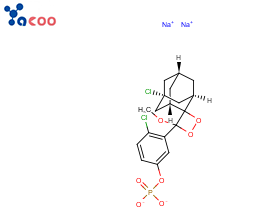2023-09-08
Product Name/English Name:[4-chloro-3-[(3S,5R)-1-chloro-3'-methoxyspiro[adamantane-4,4'-dioxetane]-3'-yl]phenyl] phosphate
English abbreviation:CDP-Star
CAS:160081-62-9
Molecular Formula:C18H19Cl2Na2O7P
Article No.:C0020
Structural Formula:

Product Introduction
CDP Star is an ALP chemiluminescent substrate that is commonly used to label biological macromolecules with ALP due to its rapid and high sensitivity characteristics. CDP Star can achieve rapid and ultra sensitive detection of biomolecules by generating extremely fast visible light. In recent years, CDP Star chemiluminescence substrates have been widely used in Western blotting techniques such as Northern blot, Southern blot, and immunoassay.
Application of CDP-Star
ALP is a type of hydrolytic enzyme that primarily removes various phosphate groups from molecules, including nucleic acids, proteins, and alkaloids. ALP has high enzyme activity in alkaline environments and is mainly distributed in the liver and bones of humans or animals. ALP is produced in large quantities during the development of adolescent bones, bone healing, and liver cell damage. During the process of new bone formation, osteoblasts express a large amount of ALP. ALP can form an alkaline environment in the body, which is conducive to calcium ion deposition and bone mineralization, thereby promoting the generation of new bone. Therefore, detecting the content of ALP in the blood can be used for the diagnosis and treatment of various clinical diseases. At present, the main methods for detecting ALP include light absorption method, electrochemical method, fluorescence method, and chemiluminescence method. The most widely used method is light absorption method. Wang Yu et al. optimized the reaction conditions for chemiluminescence detection of ALP, and the optimized reaction conditions were: 125 μmol/L CDP Star was reacted with ALP in a pH 9.5 buffer at 37℃ for 10 minutes to establish an experimental method for detecting ALP based on microplate chemiluminescence.
The results show that the detection linear range of ALP using this method is 0.05-10 U/L and 10-1000 U/L, which has advantages such as fast speed, high sensitivity, and good repeatability compared to light absorption method. This method can be developed into a reagent kit and applied to the testing and analysis of high-throughput fully automated biochemical analyzers.
References
[1]Wang Yu, Wang Zongliang, Cui Liguo, etc. Study on the Detection of Alkaline Phosphatase Based on Microporous Plate Chemiluminescence Method[J]. Analytical Chemistry Research Briefing, 2012, 8(40): 1279-1283.
Copyright © Suzhou Yacoo Science Co., Ltd. All Rights Reserved
Friendly Links :
online service